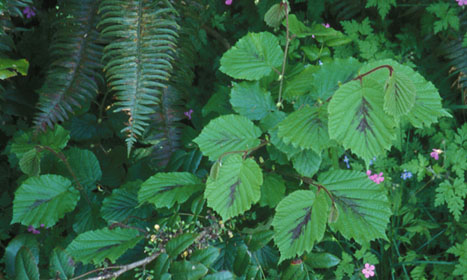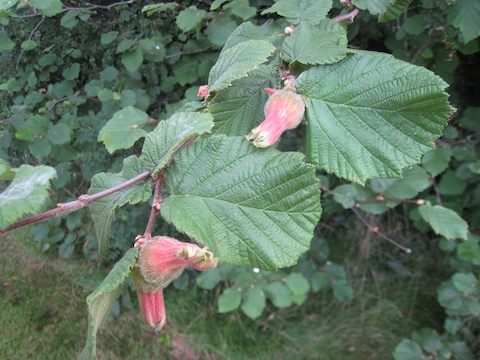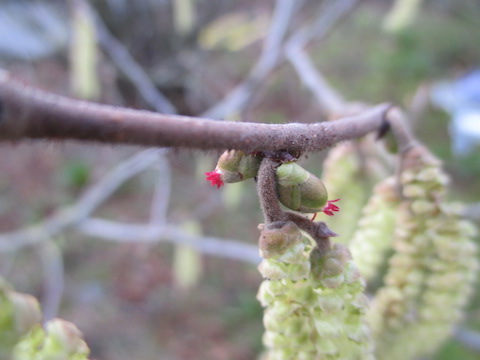
|
Hazels and Filberts in Seattle
|
| Hazels and filberts are useful, interesting and easily cared for, yet little grown and not well known in our area. Let us consider the virtues of these trees and notice their distribution and sizes recorded in Seattle. |
The fifteen species of the genus Corylus are, for the most part, shrubs or medium-sized trees. One, perhaps the largest on record, was mentioned by Ernest Wilson in 1930: "The Oriental Corylus chinensis is a very large tree and I have a vivid recollection of one giant, growing in central China, fully 120 feet tall and 18 feet in girth of trunk with a broad oval crown." Related trees include the alders, birches and hornbeams.
|
The European Hazel
|
| The English name "hazel" is of Anglo-Saxon derivation, and referred originally to the common species of Europe, Corylus Avellana. Now the term is used in many English-speaking countries. In German, hazel is called hasel, in Scandinavian hassel, in French noisettier or coudrier, in Italian avellano or nocciolo and in Spanish avellana. The English also refer to the nuts as "cobnuts," a term indicating something round or plump --perhaps related to the Irish coll or cuillean and the Welsh collen, all names for the hazel. |
| Corylus Avellana is a large shrub or rarely a small tree up to fifty feet tall. The wood is heavy and strong, but being available chiefly in small crooked pieces has had limited use as walking-sticks, fishing-rods, umbrella-handles, salmon-traps, charcoal crayons and toothpicks; in wattle and daub construction; and for dowsing-rod divination (to seek hidden sources of water, precious metals and mines, stolen goods and even criminals). The hazel suckers freely from the base of the stem, (not from the roots) and thus makes excellent coppice wood (brushwood harvested from deliberately trimmed shrubs), its abundant pliant shoots being used to make wicker baskets, bird cages, riding switches and packing material. |
European folklore concerning the hazel is varied and amusing; a pervasive theme is summed up by Kovacevic (1962) thus: "In popular belief the hazelnut is a symbol of fertility. Peasants in many parts of Europe believe that an abundance of hazelnuts in autumn presages many illegitimate children for the next year." For a first-hand account of this conviction we can do no better than read a passage from fiery William Cobbett (1762 - 1835), the famous political and agricultural pamphleteer:
|
| "This is a great nut year. I saw them hanging very thick on the way-side during a great part of this day's ride; and they put me in mind of the old saying, 'A great nut year is a great bastard year.' That is to say, the succeeding year is a great year for bastards. I once asked a farmer, who had often been overseer of the poor, whether he thought it was mere banter? He said, that he was sure that were good grounds for it; and he even cited instances in proof, and mentioned one particular year, when there were four times as many bastards as ever had been born in a year in the parish before; an effect which he ascribed solely to the crop of nuts the year before. Now, if this be the case, ought not PARSON MALTHUS, LAWYER SCARLETT, and the rest of that tribe, to turn their attention to the nut-trees? The Vice Society too, with that holy man WILBERFORCE at its head, ought to look out sharp after these mischievous nut-trees. A law to cause them all to be grubbed up, and thrown into the fire, would, certainly, be far less unreasonable than many things which we have seen and heard of." |
| Tonbridge Wells, Kent |
Saturday, 30 August 1823
|
Filberts
|
| So much for the European hazel as it occurs in the wild. Commercially cultivated hazels, called filberts (Frank Lamb wrote "a filbert is a hazel with a college education"), are mostly hybrids between Corylus Avellana and Corylus maxima, the giant filbert, which achieves thirty feet and produces large nuts. In Europe most filberts are grown in Turkey, Spain and Italy. In England most come from Kent. In the United States almost the entire commercial crop is from Oregon and southwest Washington, where filbert cultivars such as these are used: 'Barcelona' (especially), 'Butler', 'Daviana', 'DuChilly', 'Ennis' and 'Nooksack'. They are readily propagated by layering. For optimal productivity at least two different cultivars must be planted, preferably in rich soil; full sunshine is desirable but not necessary. |
The suckers ought to be pruned off to encourage development of one or a few stout trunks. Failure to remove the suckers annually will witness a big shrub, posing awkward harvesting problems. Because of the relatively few troubles associated with filbert growing here, it may be said the main tasks involved are sucker control and nut harvesting. Fertilization and crown pruning as well as other practices carried on in commercial orchards are really not suitable or needed for the casual home gardener with a couple of trees.
|
Sights in Seattle
|
| Turning to Seattle, we find an unusually rich, if not numerous, population of hazels in private gardens, cemeteries, and in both formal and informal parks and public landscapes. The fancy filbert cultivars such as 'Barcelona' seem to be found exclusively on private property. Yet the European hazel in its plain state, along with some of its ornamental cultivars, and not so fancy nut-bearing ones, has been planted in our parks. |
| The plain European hazel is perhaps best seen in Interlaken Park, where it attains 37 feet in height (52.5 feet by 1994) and has trunks nearly six inches thick. The same park has some nondescript hybrids with the influence of Corylus maxima obvious --I do not know what cultivar names to assign these. Moreover, there has been definite hybridization of Corylus Avellana planted in the park, and our native wild species Corylus cornuta (since 1984 I am not sure about this hybrid's occurrence; more study is needed). Hybridizing in hazels is so common that it is almost boring, and alas! in this particular instance the hybrid nuts are smaller than those of either parent! |
| An extremely noteworthy, rare cultivar of the European hazel is also found in Interlaken Park: the Funduk hazel (Corylus Avellana 'Funduk') distinguished only in spring, while leafing-out, when its leaves have the stigmatic sign Christians associate with the Easter season. Each leaf appears as if it had a spreading drop of blood right in the middle (SEE PHOTO ABOVE). As summer matures, the spots disappear! Perhaps one reason why this wondrous, curious plant is so rarely grown, is that many people dislike the sight of blood (though virtually never sold at nurseries or planted, 'Funduk' comes up wild here and there, so is a seed-propagating cultivar or a mere natural form). |
| Another rare cultivar is the cutleaf hazel, Corylus Avellana 'Heterophylla'. Two specimens (cut to the ground in September 2000) can be seen in Lakeview Park in the Denny-Blaine neighborhood. Although many trees have cutleaf cultivars, few are commonly grown hereabouts with the exception of the Japanese maple (Acer palmatum, many clones), European white birch (Betula pendula 'Dalecarlica' ('Crispa') etc.), and staghorn sumach (Rhus typhina 'Dissecta'). The comparative rarity of cutleaf trees may be due to their reduced vigor and their greater susceptibility to aphid attacks and other debilitating influences. |
| The corkscrew hazel or Harry Lauder's walking-stick (Corylus Avellana 'Contorta'), is a radically twisted, slow-growing, bushy cultivar of the hazel. (It was discovered growing in a hedge in Gloucestershire, England, in 1863.) When it blooms it serves as a particularly arresting feature of the scenery. An expensive plant, it is uncommon, yet by no means as rare as the aforementioned kinds. None seem to be in the parks, unless the fine Arboretum one be counted. Most are in private gardens; it has been used in the landscaping at Seattle University and at Washelli Cemetery, and two have been planted as street-trees on Queen Anne Hill (W Raye Street west of 10th Avenue W). It is quite a fair nut-producer besides being a distinctive novelty plant; nor does it sucker as much as the other kinds. |
| The golden hazel (Corylus Avellana 'Aurea'), bearing yellow foliage, is said to be planted somewhere on Queen Anne Hill. I have yet to find it anywhere but Marvin Black, city arborist of Seattle, assures me a home on south Queen Anne has a foundation planting of it (I located it; the growth is weak and this cultivar is wholly shrubby). |
Most of the purple-leaf cultivars here are derived from Corylus maxima, the giant filbert, including the 'Purpurea' clone that is so common, and so very dark. The nuts it bears are very different from the nuts of the other filberts. Another purple-leaf hazel, perhaps no longer planted, displaying more of a bronzy-green color, is the 'Fusco Rubra' cultivar of Corylus Avellana. The Arboretum has the purple-leaved Corylus maxima 'Atropurpurea Superba'.
|
Our Native Hazel
|
| The hazel native to the Seattle area, called in books the California or Western beaked hazel, is Corylus cornuta var. californica. It is one of the most common understory elements in the woods of the Seattle area. Usually it is a shrub, no question about it. On mucky clay soils it is a pitiful, scrawny spectacle indeed; but in rich forest humus a truly enormous shrub can develop a single thick trunk (or just a few) ringed by slender suckers. A hazel without any suckers is unheard of, and open-grown hazels in full sunshine become veritable bush pin-cushions. In short, hazel is much like the vine maple in the matter of growth habit, only worse. |
| How large can our native hazel become? Most authors of tree books totally ignore it; those that mention it usually assign it a maximum height of 20 or 25 feet, and do not supply trunk diameters at all. Eliot (1948) says the biggest he had heard of ". . . was about a foot through . . ." Thomas Howell in his A Flora of Northwest America (1903), allows it 30 feet, a figure that seems a reasonable average maximum height, but that might be scoffed at by one T.J. May, who, from his home in Mount Vernon, sent a letter to the USDA (1896), saying in part: "Hazelnuts flourish here as in no other country that I ever saw; they are native and grow all through the timber. They grow on trees instead of bushes; many of them growing to the height of 50 or 60 feet . . ." |
| According to the American Forestry Association's "National Register" of big trees, the largest hazel currently on record is one in the Maples Park of the Siuslaw National Forest, Oregon, that in 1972 measured 22 feet tall, 20 feet in average crown spread, and 6.7 inches dbh of trunk. Whether this tree is single-trunked or whether it has several with only the thickest listed, is unspecified. Whatever the case, Seattle's largest native hazel is about twice this size and has been nominated as the new champion, to usurp the throne from the one in Oregon! The statistics of our best (in Carkeek Park) are: 47 feet in height for its tallest trunk, 46 for its second tallest, 42 feet the average crown spread --a figure explained by the tree being several-trunked and having two more or less laterally-growing trunks-- and seven inches dbh of the thickest trunk. Finding hazels of similar height is not hard, but to locate one combining such thick trunks, lofty height and umbrageous width of branches, is a task few would undertake (but in 1990 one at Golden Gardens Park measured 41 feet tall, 51 feet wide, its stoutest trunk 9 inches thick). |
A melancholy opportunity to assess the age of an unusually large example of our native hazel presented itself one day last February when an enormous specimen was cut down in Interlaken Park. The butt log carried away measured just over five feet long and scaled 70 pounds. At the thinnest point its diameter was more than six inches. The bark was one-eighth of an inch thick. No heartwood was present; the age by ring count appeared to be 38 years. By extrapolation, and by bearing in mind that Carkeek Park was logged sometime in the 1920s, we might estimate the age of the proposed national champion there, at not likely more than 50 years. Apparently an individual trunk of hazel is relatively short lived but the clump as a whole has a virtually indefinite ability to send up new stems.
|
Flowering and Fruiting
|
| Most non-native hazels begin to flower as early as January. Our native species flowers in February (or early March), with conspicuous golden male catkins lengthening to three to five inches when loosely hanging from the twigs, and inconspicuous tiny crimson female flowers. By late June and early July at least some nuts are ripe enough to be eaten, albeit not fully ripe in a physiological sense. For our area, at any rate, this sets to rest the traditional notion of Autumn nut-harvesting! Indeed, if one searches for native hazelnuts after mid-August, the attempt will likely be in vain; by then squirrels and jays will have nabbed all but a precious few. |
| The nuts of the non-native hazels and filberts ripen later, even if the trees flower earlier. Mid-August through late September is prime harvest time. I wait until I notice a squirrel cracking nuts and littering the ground with husks. Then, with gloves, a container and clippers, collecting begins. When the squirrels grow annoyed or frightened they sometimes throw nuts down, which is a boon, as many nuts grow so high that there is no way a person could reach them without a ladder. |
The long fibrous husks encasing the native nuts (like a sock around a tennis ball) are covered with bristly hairs which are irritating to human skin, and thus lead to the recommendation of gloves. The freshly gathered nuts prove easier to crack, and their nutmeats moister, than the old, dry, store-bought filberts. Sometimes the nuts are borne in pairs or threes, rarely even four to a cluster. A certain percentage always turn out to be "blanks" or immature nuts. Squirrels can somehow distinguish these without even cracking them; our only method is the water test, wherein the good ones sink and the hollow ones swim. At any rate, the way to obtain nuts is to compete with squirrels and jays, visit a "u-pick" orchard, or buy filberts from a store.
|

ripe nuts of the native hazel in Seattle; photo by ALJ
|

red female & yellow male hazel flowers; photo by ALJ
|
Other Kinds of Hazels in Seattle
|
| Besides the native and the various European hazels, there are at least three others here. The Turkish, or Constantinople hazel, Corylus Colurna, is found at the Arboretum where two low-crowned trees bear plentiful crops regularly; and at Volunteer Park where a huge specimen stands 62 feet tall and girths 4 feet 4 inches at breast height, but alas, bears duds, perhaps because it lacks a partner for cross pollination. (Specimens of Turkish Hazel are also at the Ballard Locks and the U.W. campus; and hybrids between the Filbert and the Turkish Hazel have been planted in Seattle.) The Turkish nuts are encased in enormous, fiercely ornamental husks, but the nutmeats are small. |
| Two kinds found only at the Arboretum are the Japanese hazel, Corylus Sieboldiana, and #356-69, received as Corylus tibetica in 1969 but the identification has not been confirmed; both of these produce nuts. Portland's Hoyt Arboretum has four Chinese hazels, Corylus chinensis, planted in 1944. |
| Another to be expected is the weeping European Hazel, Corylus Avellana 'Pendula'. Readers interested in the exact locations of specimens mentioned in this article, or in seeing samples of the various kinds of nuts, are invited to consult the writer. It would be satisfying to help spread the cultivation of hazels in Seattle. |
Here, then, follows a list of the various hazels in Seattle.
|
| Corylus Avellana (European hazel) |
| Corylus Avellana 'Aurea' (Golden hazel) |
| Corylus Avellana 'Contorta' (Corkscrew hazel) |
| Corylus Avellana 'Fusco Rubra' (Purpleleaf hazel) |
| Corylus Avellana 'Heterophylla' (Cutleaf hazel) |
| Corylus Avellana x Corylus maxima (park hybrids) |
| Corylus Avellana x Corylus maxima (Filbert cultivars, such as 'Barcelona') |
| Corylus Avellana x Corylus cornuta var. californica (native hybrid) |
| Corylus cornuta var. californica (Western beaked or native hazel) |
| Corylus Colurna (Turkish hazel) |
| Corylus maxima 'Purpurea' (Purpleleaf giant filbert) |
| Corylus Sieboldiana (Japanese hazel) |
Corylus #356-69 (Corylus tibetica?)
|
| REFERENCES |
| - American Forestry Association. See issues of American Forests April 1973, April 1978, April 1982, for "National Registers." |
| - Cobbett, William. 1830. Rural Rides. Many editions. |
| - Eliot, Willard A. 1948. Forest Trees of the Pacific Coast. Revised edition, G.P. Putnam's Sons, New York. p. 386. |
| - Howell, Thomas. 1903. A Flora of Northwest America. Portland. p. 613. |
| - Kovacevic, Ivo. 1962. The Basic Principles of the Cultivation and Selection of Hazelnuts. Translated from the Serbo-Croatian by Spalatin Leonardo, published for the N.S.F. (Wash. D.C.) and the U.S.D.A. by the NOLIT Publishing House, Belgrade. p. 9. |
| - U.S.D.A. Division of Pomology. 1896. Nut Culture in the United States. Ed. by W.P. Corsa. G.P.O., Wash. D.C. p. 76. |
- Wilson, Ernest. 1930. Aristocrats of the Trees. The Stratford Co., Boston. p. 223.
|
Originally published in the Spring 1984 University of Washington Arboretum Bulletin, pages 12 - 18, along with 6 photographs.
Back |
|
|

